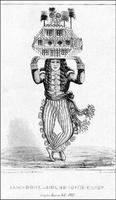
Jonkunnu
At the heart of the exhibition will be the remarkable series of lithographs, Sketches of Character.
The National Gallery of Jamaica on March 2 will be opening an abridged and amended version of the Yale Centre of British Art's exhibition titled 'Isaac Mendes Belisario: Art and Emancipation in Jamaica'. This exhibition will be utilising the Jamaican loans to the original exhibition and additional loans from various Jamaican collections. Approximately 150 objects, including paintings, sculptures, furniture, rare books and documents, costumes and musical instruments will be presented.
Curated by Gillian Forrester, associate curator of prints and drawings, Yale Center for British Art; Tim Barringer, Paul Mellon, Professor of the History of Art, Yale University; and Barbaro Martinez-Ruiz, assistant professor, Department of Art and Art History, Stanford University, the exhibition examined the visual culture of slavery and emancipation in Jamaica.
234 works of art
It was organised to commemorate the bicentenary of the abolition of the British slave trade and featured some 234 works of art and objects drawn from Yale's own collections and from museums and private collections in Britain, France and Jamaica. Generous support for this project was provided by The Reed Foundation.
The exhibition also chronicles the iconography of sugar, slavery, and the topography of Jamaica, from the beginning of British rule in 1655 to the aftermath of emancipation in the 1840s, with a particular focus on the turbulent years preceding and immediately following emancipation in 1838. Gathered together will be paintings, drawings, and prints depicting life on the Jamaican and West Indian sugar plantation and images used by the anti-slavery campaign.
The works of major British artists of the period who visited Jamaica - George Robertson, Phillip Wickstead, James Hakewill and Joseph Kidd - as well as the French-born lithographer and daguerreotypist Adolphe Duperly, will be presented alongside those of the Jewish, Jamaican-born artist Isaac Mendes Belisario, who practised in London before returning to Jamaica to establish a studio here.
Series of lithographs
At the heart of the exhibition will be the remarkable series of lithographs, Sketches of Character, an illustration of the habits, occupation, and costume of the Negro population in the island of Jamaica, published by Belisario in collaboration with the lithographer Adolphe Duperly, in 1837-38.
Sketches of Character provides the first detailed visual representation of Jonkunnu (or John Canoe), the celebrated Afro-Jamaican masquerade performed by the enslaved during the Christmas and New Year holidays.
Tracing the West African roots of Jonkunnu, its evolution in Jamaica, and continuing transformation into the 21st century, the exhibition will feature subsequent manifestations of Jonkunnu through costumes, musical instruments and video footage of historic and contemporary performance.
'Isaac Mendes Belisario: Art and Emancipation in Jamaica' is made possible through the support of Pan Jamaican Investment Trust Ltd. and is presented in the context of the group of exhibitions mounted at the National Gallery of Jamaica and at the Institute of Jamaica Galleries commemorating the bicentenary of the abolition of the British slave trade, titled 'Materialising Slavery: Art, Artefact, Memory and Identity' (September 16, 2007-April 12, 2008). This group of exhibitions is a collaboration of the National Gallery and the Museums Division of the Institute of Jamaica.
To accompany the exhibition, a catalogue will be available in the gift shop. Images from the exhibition will be available on request.

